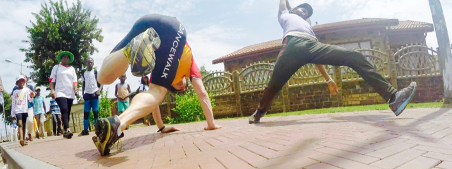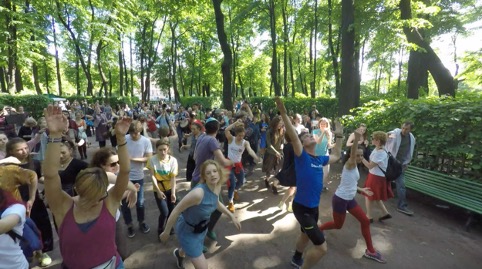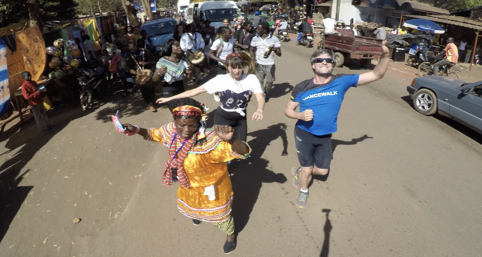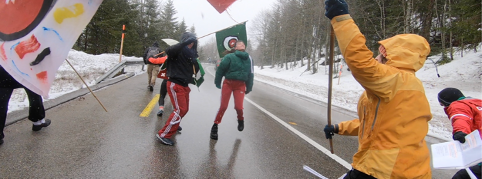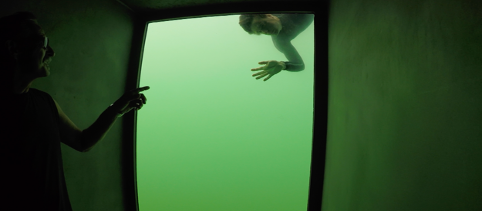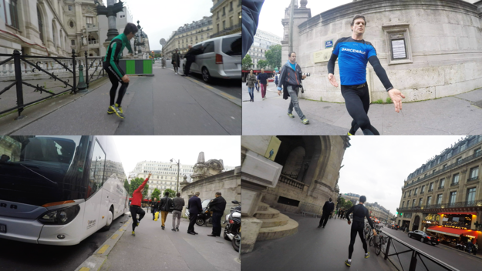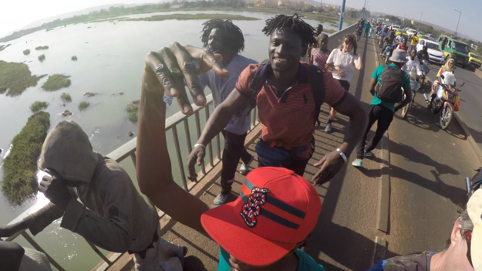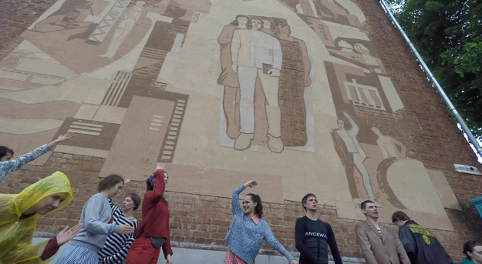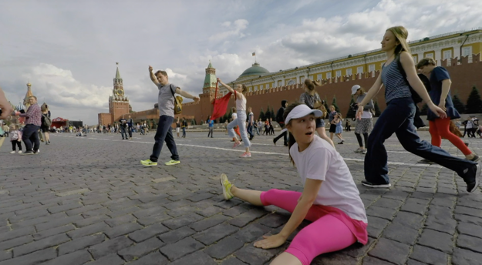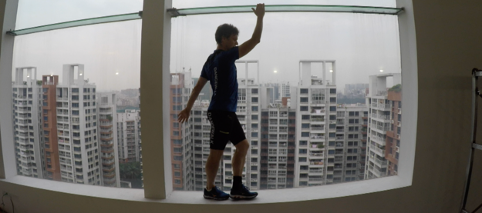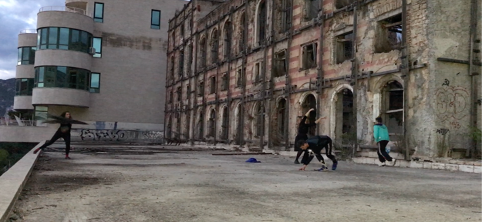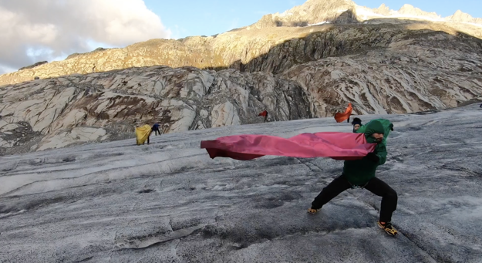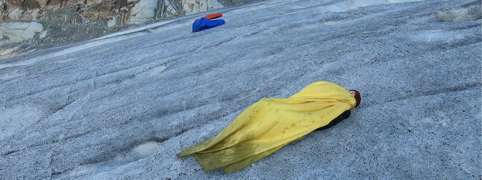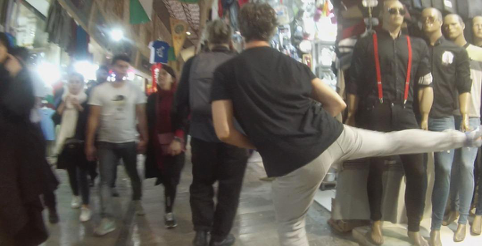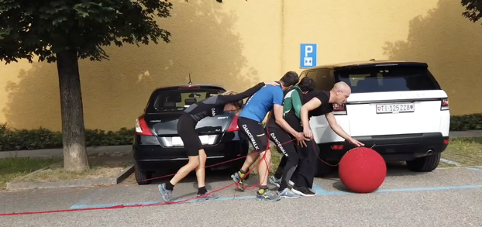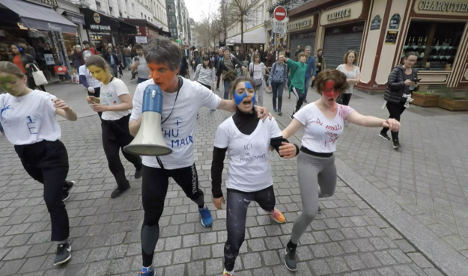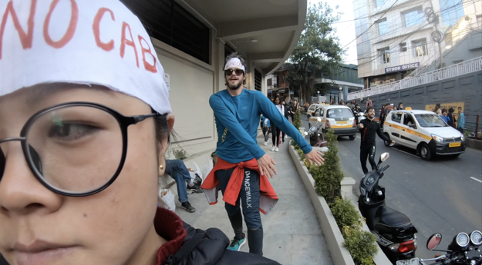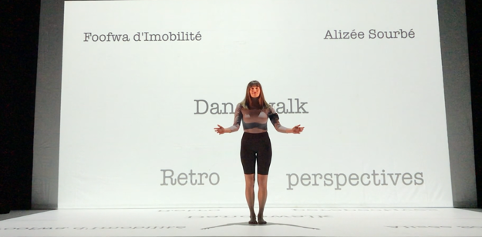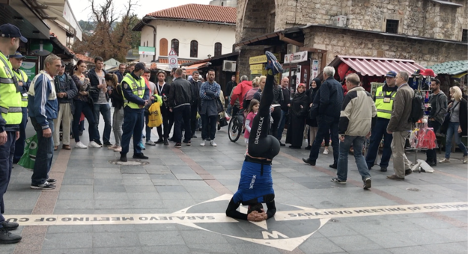Dancewalk
Dancewalk is dance as voyage, everywhere in the world.
If dancing, even on the greatest stages, is basically stationary,
Conversely, the Dancewalk is dance that travels.
Dancewalking is a continuous displacement of oneself
That asserts its unicity and strives for freedom.
It is an artistic, kilometric, urbanistic, social, landscaping,
Collaborative, celebratory,
Political and humanist act.
The Dancewalk in a few words
Designed as a geographic inscription of body and dance, the Dancewalk is an activity where walking becomes dancing, where dance keeps moving over several kilometres and for several hours through a city or the countryside.
Swiss dancer-choreographer Foofwa d’Imobilité is the inventor of this concept and activity. Since 2015, he has dancewalked over more than 900 kilometres in 34 regions and 11 countries over 50 Dancewalks organised in collaboration with local teams, including an increasing number of local dancers, workshop participants, musicians and partners.
On every occasion, his company Neopost Foofwa has adapted the Dancewalk to the place, the moment and the context in which it took place, in collaboration with local organisations whether the performance happened in Switzerland, France, Italy, Bosnia-Herzegovina, Russia, Iran, Mali, Burkina Faso, South Africa, India or China.
The Dancewalk is a human adventure and an artistic act in the way it adapts to, shares and collaborates with others, as well as the way it expresses itself through the act of being-together in the public space. It is a celebration of life, an ode to freedom, an emancipation of oneself within the group and a declaration of cohesion that includes everyone’s differences and particularities.
Conceptual approach and artistic particularities
Might the Dancewalk be a new dance form?
Might it be a new artform of our bipedalism?
For Foofwa, dancewalking defies the normative aesthetic of dance in its kinaesthetic, choreographic and conceptual dimensions.
In terms of movement, the Dancewalk creates a new kinaesthetic coordination that combines dance with walking and remixes the top and bottom parts of our body’s connexions. It considers dance both qualitatively and quantitatively. It opens up on all sorts of movements that are both dynamic and powerful, and vulnerable and wearying. It originates from very specific, at times extreme training and preparation sessions, dancing over dozens or hundreds of kilometres. At the same time, it is not elitist in the least: anyone can dancewalk, whether trained or not, at their own level and in their own way. At the time of the performance, it is actuated by listening sensitively to the energy and desires of our bodies and spirits interacting with the intention, the context, the other people and the environment. A dancewalker is both focused on the performance and open to discussion in interaction with others and the environment, which makes for this blend of application and casualness.
The Dancewalk is the hybrid child of dancing and walking.
It is a dancing monster that devours hours and kilometres.
It is a demiurge that writes choreography in space and time.
It is a geographic dancer with endurance as a muse.
Dancewalk!
Artistic grenade thrower!
Emancipation from the theatrical frame!
Dynamite!
Emancipation from the choreographic stranglehold!
Openness to the unpredictable!
Emancipation of the role of audience!
Explosions!
In choreographic terms the Dancewalk should be considered as a real performance both artistically- and athletically-speaking. Foofwa also views it as a metaphor of the way we write our destiny (“The course of our lives, the path of our own stories”), where everyone can finally publicly assert their personal way of moving, declaiming their body and its unique, specific and idiosyncratic qualities to the world. In that sense, it moves away from formalist and aesthetic dances to become an act of inclusion and acceptance of all differences. Sometimes sections are practiced ahead in a specific way or according to a theme, but the Dancewalk never forces or compels participants to be anything other than themselves and what they seek to express. The duration of the performance and the repetitive rhythm of the steps often puts performers in an altered state close to trance. Certain moments resemble what we know of the manic dances like the Middle-Age ‘danses de Saint Guy’.
In conceptual terms, the Dancewalk creates a new choreographic relationship between dance, duration and space, by stretching them to the extreme because it considers time in terms of several hours, and views space in terms of multiple kilometres. Furthermore, it gives dance a geographic dimension, e.g. one can follow the choreographic movements thanks to a GPS recording on a map. In that sense, Foofwa considers that it originates in the field of choreographic art while flirting with other activities and disciplines, as in actual fact, an unknown, yet oddly familiar hybrid emerges from two known activities: dancing and walking. It is reminiscent of Monty Pythons’ “silly walks”, although the range of movements in a Dancewalk spreads far beyond humour and caricature. It is also reminiscent of conceptual performances that revolve around walking or Land Art. It is reminiscent of flash mobs, although much more thought-out and practiced while being more spontaneous and anarchic too. Finally, it is reminiscent of a postmodern approach to walking as a dance element in the choreographic field but once again, the Dancewalk does not rely on walking, it feeds off the human condition of having to walk on two legs in order to invent a new dance gait. Dancewalk can also be considered as the opposite of walking, like a dance form that seeks to never “just” walk.
Dancewalking is like spreading the cabriole,
It is replacing gloominess with dynamic cheeriness.
Dancewalking is a cadence that moves forward happily.
It is joyful starting cells as medicine.
And therapy through uncynical kinetics.
When dance becomes geographic
Happiness lies on the horizon!
In terms of the environment the Dancewalk interacts with the world and reality with such permeability as is rarely achievable in dance or on stage. These dialogues between things, people and the Dancewalk presuppose much porosity with reality and an intrinsic relationship with the unpredictability of the environment. Here, the work of art is in conversation with reality. First of all there is the space, constantly changing with ‘luxury scenery’ passing by – how many millions to erect this mountain or this building with so many extras? Then there are also the other sounds, the other movements of the world that become so many encounters and exchanges with the Dancewalk. Finally, there are the hundreds, sometimes thousands of onlookers, either informed or accidental who interact with the Dancewalk and its actors. The boundaries between art and reality are blurred. The roles of performer and spectator are upturned.
How to organise a Dancewalk
In line with the commitment of Cie Neopost Foofwa’s Glocal project, our way of touring choreographic productions since 2018 has focused on notions of openness, awareness and ethics in a globalised world. By seeking to avoid colonialist, patriarchal and neoliberal influences, we aim to create and share our works in a more conscious, responsible and humble way, by developing production relationships and touring strategies oriented towards encounters, dialogue, sharing and collaboration.
In that sense, a “glocal” work of art like a Dancewalk is no longer designed like a post-industrial object to be reproduced and distributed left, right and centre. Its production becomes a living work that requires the inclusion of local characteristics to be complete, and the collaboration of others on site to be carried out in a fair and unique way. The Dancewalk projects have served as models since the dialogue with venues has been strongly developed since 2017.
Concretely, the organisation of an outdoor Dancewalk is light in terms of technical requirements, since it does not take place inside a theatre. However, it does require significant investment in terms of time, logistics and human resources.
First of all there is a creative dialogue between Neopost Foofwa and the organisers in order to adapt the Dancewalk concept to the specificities of the place. This dialogue begins several months before the event and continues until the last hours before the performance. Then, there are certain specific logistical details, which is why we do not have a technical specifications sheet but rather a logistics and technical rider, which we call our “Dancewalk Logistech”, to prepare and manage the Dancewalk as best as possible.
This is why we ask the organisers to read this Logistech rider attentively and well in advance.
Excerpts or full versions of all the Dancewalks are available on our Neopost Foofwa Vimeo account
History of the Dancewalks
Between 2003 and 2010: The Danceruns
In some 15 cities throughout Switzerland, France, Italy and Egypt, Foofwa invented and performed the Dancerun, the forbearer of the Dancewalk which was faster but shorter in terms of time and distance.
2015: First Dancewalk experiments
In 2015, the very first Dancewalk was a three-day-long, 100-kilometre danced meander from Saignelégier to Yverdon-les-Bains. That same year, Foofwa danced in Nordic walking competitions and dancewalked naked in the streets of Bienne for one hour during the Festival Body & Freedom.
2016: Exploring different variations of the solo Dancewalk
In 2016, the Dancewalk saw endless variations in Switzerland, Italy and France. On 21 June, on the day of the summer solstice, Foofwa did 100 danced revolutions around Opera Garnier, i.e. 62 kilometres in 12.5 hours with Circumvolution.Dancewalk (ParisOpera).
2017: The Dancewalks become increasingly social and collaborative with other dancers, musicians and workshop participants
Dancewalks have been shared in South Africa, Russia and Bosnia-Herzegovina. Talking closely with local organisers, Neopost Foofwa carefully prepares and significantly adapts each Dancewalk to the city, the residents and the context in which it takes place. On site, Foofwa carries out Dancewalk workshops open to all and invites participants to join him in the performance. The festive and liberating aspect of the Dancewalk stands out more strongly.
2018: Two more symbolic and political Dancewalks
The Dancewalk becomes more political in 2018: Dancewalk – Mai 2068 takes place in a group and with megaphone in hand in Paris, in the footsteps of May 1968. A clandestine Dancewalk follows in the streets of Tehran, a country that strictly forbids dance in the public space.
2019: Exploring different variations of group Dancewalks, with more collaborations and partnerships
In 2019, Foofwa, always in the company of other dancers of his company as well as local professionals, dancewalks in the heat in Mali and Burkina Faso, then under the snow with 600 walkers for the Independence March in Neuchâtel. In Ticino, France, Russia and India, the Dancewalks echo social, political and ecological conflicts. With Dancewalk – Ultra Valais, the company creates a unique performance: Foofwa, in the company of 5 other dancers, dances for 243 kilometres through the Canton of Valais in 10 days. Each day, they address a topic that relates to the places visited and to the partners in each region.
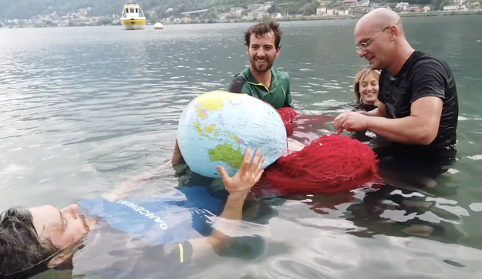
Dancewalk – Ticino (2019) – Collaboration with artist Ilja Luginbühl, Stabio – Riva San Vitale, Switzerland
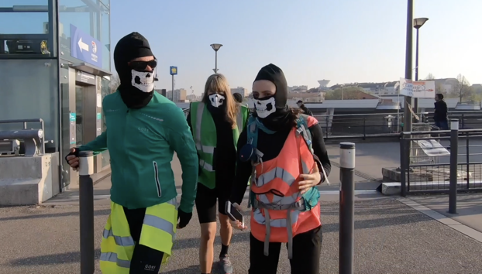
Dancewalk – Du vert sinon j’étouffe (2019) – Dancewalking as resistance, Paris – Villecresnes, France
2020 and the future: Spreading and diversifying the Dancewalk
Nowadays the company continues to offer Dancewalks in the public space. Since late 2018, the idea has also been to share these adventures indoors, in a theatre, with the dance piece Dancewalk – Retroperspectives. Paradoxically designed for the stage, the dance piece is an analytical, historical, poetic and audio-visual story that covers the 700 kilometres of Dancewalk performed through 33 regions in 11 countries around the world. This exercise in style enables the audience, thanks to a video projection installation and the presence of dancer Alizée Sourbé, to roam the world in communion with the various places, people, concepts and realizations.
PRESS
Le 19h30 – RTS, 9 May 2015 (French)
Dance Event: A Geneva dancer covers 100 kilometres in three days while dancing (French)
Stepping Out of the Centre: Live Art Festival 2017 / Artthrob – 22.02.17
Le Monde, 9 April 2018 – Les Amandiers take up the May 1968 legacy (French)
Laurent Carpentier
“A tribute to May ‘68 at Théâtre de Nanterre was inaugurated by ‘dancewalk’ choreographer ‘Foofwa’…
Since then, his Dancewalk has featured in Sarajevo and Soweto, on Red Square in Moscow, in la Chaux-de-Fonds, jumping from one Swiss canton to the next… ‘Beauty will be convulsive or will not be’, blares the megaphone. Slogans like mantras. To soak them up, he explains the evening before, ‘We always want to change the world through our actions, but our scope is limited. Humbly, we have to change ourselves first, then see what that changes between us and ultimately, if it spreads to the public. Dancewalk is an area of truly anarchic freedom. There is no watchword, everyone is free to assert their performance. The interesting thing is not to duplicate the pitfall of May 1968, but to take inspiration from it, using the body’.”
Ma Culture, 10 April 2019, Interviews – Foofwa d’Imobilité “Drawing this freedom which is inside the body towards the outside” (French)
Marie Pons
“How does one dancewalk? How do you pass on the principle during a workshop when the group is invited to join the route with you for example? Bizarrely, there’s something quite natural in the dancewalk. The workshops gather people aged 5 to 85. In the beginning, I ask everyone to walk, then to choose a space, to be aware if they’re going left or right, if they’re turning in circles, to be attentive to their decision of inscribing their life, their body, their being in the chosen space, which is a real choice in itself, a choice of freedom. And then we listen to our appearance, our beings. So, based on walking, we see how we can inscribe ourselves in space and time in a just way, in accordance with ourselves. It’s very important for me to remind everyone that we are free and responsible people, and it’s our primary choice in this context to walk and move forwards. And to wonder about the choices we make, how we relate to others…”
Le Nouvelliste, 6 May 2019 – The “Brig Naters to me” Dancewalk has found its audience (French)
Xavier Duroux
“Constant improvisation
Moving from one side to the other of the road, the choreographer combines walking with dancing with baffling skill. Everything is a pretext for the improvisation of original choreography which the public watches carefully and comments on happily. We can’t feel the wind anymore, we don’t think about anything else, only the show holds their attention. Even car drivers stop to watch this unusual and surprising exhibition.”
